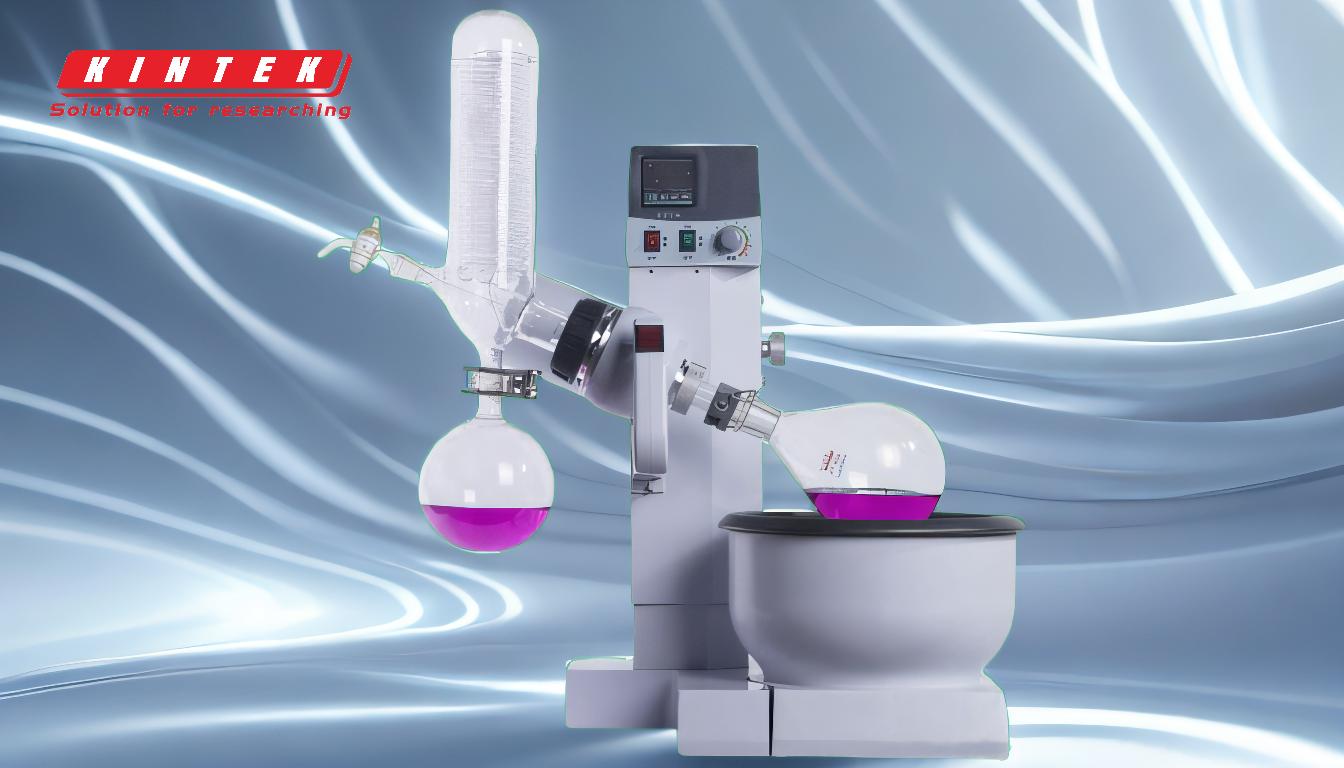Rotary evaporation and recrystallization are two distinct techniques used in chemistry for different purposes. Rotary evaporation is primarily used for solvent removal, particularly for heat-sensitive compounds, by applying vacuum to lower boiling temperatures and achieve faster evaporation rates. The residue (concentrated compound) is retained in the original flask. On the other hand, recrystallization is a purification technique used to isolate and purify solid compounds by dissolving them in a solvent at high temperatures and then allowing the solution to cool, causing the compound to crystallize out in a purer form. While rotary evaporation focuses on solvent removal, recrystallization focuses on purification through crystallization.
Key Points Explained:

-
Purpose and Application:
- Rotary Evaporation: Used for solvent removal, especially for heat-sensitive compounds like APIs. It is ideal for concentrating solutions by evaporating solvents under reduced pressure.
- Recrystallization: Used for purifying solid compounds. It involves dissolving the compound in a solvent, filtering out impurities, and then allowing the compound to crystallize as the solution cools.
-
Mechanism:
- Rotary Evaporation: Operates under reduced pressure (vacuum) to lower the boiling point of solvents, enabling evaporation at lower temperatures. The solvent is evaporated, and the residue (concentrated compound) remains in the original flask.
- Recrystallization: Involves dissolving the compound in a hot solvent, filtering to remove insoluble impurities, and then cooling the solution to allow the compound to crystallize. The purified crystals are then collected.
-
Equipment:
- Rotary Evaporation: Requires a rotary evaporator, which includes a rotating flask, vacuum system, heating bath, and condenser. The rotating flask increases the surface area for faster evaporation.
- Recrystallization: Requires basic lab equipment such as a hot plate, beaker, filter paper, and a cooling apparatus. No specialized vacuum or rotating system is needed.
-
Temperature and Pressure:
- Rotary Evaporation: Operates at reduced pressure and moderate temperatures to prevent degradation of heat-sensitive materials. The vacuum lowers the boiling point of the solvent.
- Recrystallization: Requires heating the solvent to dissolve the compound fully, followed by cooling to induce crystallization. The process is typically carried out at atmospheric pressure.
-
Outcome:
- Rotary Evaporation: The outcome is a concentrated solution or residue in the original flask, with the solvent removed. It is not a purification technique but rather a concentration method.
- Recrystallization: The outcome is purified solid crystals, free from impurities. It is a purification technique that improves the purity of the compound.
-
Applications:
- Rotary Evaporation: Commonly used in pharmaceutical, chemical, and food industries for concentrating solutions, removing solvents, and isolating compounds.
- Recrystallization: Widely used in organic chemistry labs for purifying solid compounds, especially when high purity is required for further analysis or synthesis.
-
Advantages:
- Rotary Evaporation: Efficient for solvent removal, especially for high-boiling-point solvents. It minimizes thermal degradation of sensitive compounds.
- Recrystallization: Effective for purifying solids, removing soluble and insoluble impurities, and obtaining high-purity crystals.
-
Limitations:
- Rotary Evaporation: Not suitable for purification; it only concentrates compounds. Requires specialized equipment and may not be effective for very high-boiling-point solvents.
- Recrystallization: Requires a suitable solvent system, and the process can be time-consuming. It may not be effective for compounds that do not crystallize well.
By understanding these key differences, a purchaser can choose the appropriate technique based on whether the goal is solvent removal (rotary evaporation) or purification (recrystallization). Each method has its unique advantages and applications, making them indispensable in different contexts within the laboratory.
Summary Table:
| Aspect | Rotary Evaporation | Recrystallization |
|---|---|---|
| Purpose | Solvent removal, concentration of solutions | Purification of solid compounds |
| Mechanism | Operates under vacuum to lower boiling points, evaporating solvent | Dissolves compound in hot solvent, cools to form purified crystals |
| Equipment | Rotary evaporator (rotating flask, vacuum system, heating bath, condenser) | Basic lab equipment (hot plate, beaker, filter paper, cooling apparatus) |
| Temperature & Pressure | Reduced pressure, moderate temperatures | Atmospheric pressure, heating followed by cooling |
| Outcome | Concentrated residue in flask | Purified solid crystals |
| Applications | Pharmaceutical, chemical, food industries | Organic chemistry labs for high-purity compounds |
| Advantages | Efficient solvent removal, minimizes thermal degradation | Effective purification, removes soluble and insoluble impurities |
| Limitations | Not for purification, requires specialized equipment | Time-consuming, requires suitable solvent system |
Need help deciding between rotary evaporation and recrystallization? Contact our experts today for tailored advice!










